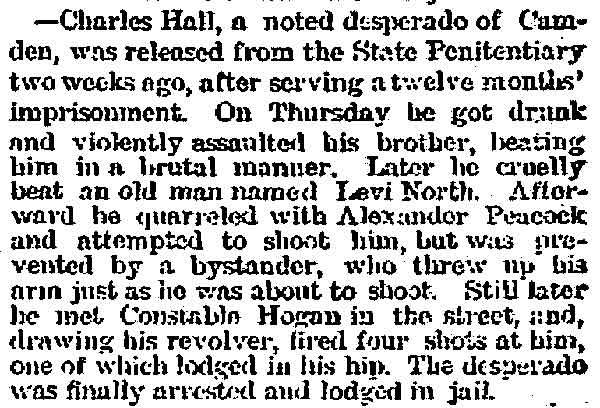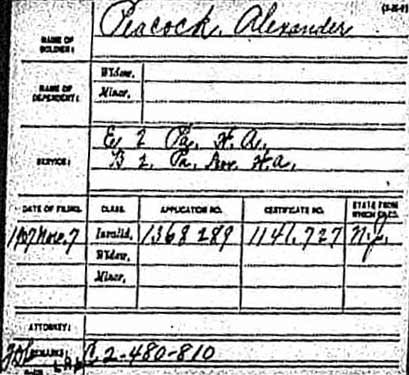|
Alexander Peacock was born in New Jersey in August of 1844 to Clayton and Doretha Peacock. He was named
after his grandfather. Clayton Peacock worked as a house carpenter, and Alexander worked in that profession throughout his life. The 1850 Census
shows the family living in Camden's South Ward. Alexander, then 6, was the oldest child at home, also there were Elizabeth, 5; Martha, 3; and
Thomas, 10 months. Two more daughters came by 1860, Amanda and Ellen.
Alexander Peacock enlisted as a Corporal on February 13, 1864 in Company E, 2nd Heavy Artillery Regiment
Pennsylvania. The 112th Regiment, 2nd Heavy Artillery, whose members were principally from the counties of Franklin, Allegheny and Monroe, was
mustered in at Philadelphia in January, 1862, for three years. On January 9, three companies were ordered to Fort Delaware and the remaining
companies moved to Washington on February 25, when they were assigned to duty at Bladensburg, Maryland, where the command was reunited on March
19, and in November, two independent companies from Fort Delaware were added to the regiment. The regiment remained at Bladensburg until March,
1864, when it was ordered to the forts near Chain bridge. So large a number of recruits were added to the originally large regiment, that in April,
the 2nd Provisional Heavy Artillery was organized from the surplus, the two regiments numbering 3,300 men. The 2nd was attached to the 9th corps and
participated in the Wilderness campaign, fighting at Spottsylvania and Cold Harbor. The 1st regiment joined the Army of the Potomac at Cold Harbor
on June 4, when it was divided into three battalions and attached to the 18th corps. The 2nd battalion shared in the charge at Petersburg on June
18, by which the ground was gained that became the front line of the army. The provisional regiment joined the 1st on Aug. 26, 1864, having been on
duty at Petersburg and active at the explosion of the mine, where it lost heavily. Its ranks were by this time reduced to 400 men. In a charge on
September 20, the 1st and 2nd battalions lost 200 men, after which they were stationed with the remainder of the regiment near Fort Harrison until
December. In January of 1865, a large number of the men re-enlisted and the regiment joined in last charges upon the enemy's works, afterward
entering the city with the army.
In the aftermath of this action, Alexander Peacock was promoted to Full Corporal on May 1, 1865.
For the remainder of the year the regiment was occupied in detachments in preserving peace and order in the
southern part of Virginia. Returning to City Point, Virginia, it was there mustered out on Jan. 29, 1866. Corporal
Peacock was among those who mustered out of Company E, 2nd Heavy Artillery Regiment Pennsylvania on January 29, 1866 at City Point, Virginia.
On September 2, 1869 City Council enacted a municipal ordinance creating a paid fire department. It provided
for the annual appointment of five Fire Commissioners, one Chief Marshal (Chief of Department) and two Assistant Marshals. The City was also divided
into two fire districts. The boundary line ran east and west, starting at Bridge
Avenue and following the tracks of the Camden and Amboy Railroad to the city limits. District 1 was south of this line and District 2 was
north. The commissioners also appointed the firemen who were scheduled to work six 24 hour tours per week.
William Abels, from the Weccacoe Hose Company No. 2 was appointed Chief Marshal with
William J. Mines, from the Independence Fire Company No. 3 as Assistant Marshal for the 1st
District, and William H. Shearman as the Assistant Marshal for the 2nd District.
Abels had served with the volunteer fire departments of Philadelphia, Mobile, Alabama and Camden
for sixteen years prior to his appointment as Chief of the paid force.
On
November 10, 1869 City Council purchased the Independence Firehouse,
the three-story brick building at 409
Pine
Street, for $4500. The
building was designated to serve as quarters for
Engine Company 1
and
the 1st District. On October 29, 1869 City Council authorized
construction of a two-story brick building on the northwest corner of
Fifth
and
Arch
Streets as quarters for the 2nd
District. On November
25th the Fire Commissioners signed a contract with M.N. Dubois in the
amount of $3100 to erect this structure. The 2nd District would share
these quarters with Engine
Company 2 and the
Hook
& Ladder Company
and the facility would also serve as department
headquarters
for the new paid force. The original contract remains part of the
Camden County Historical Society collection.
|
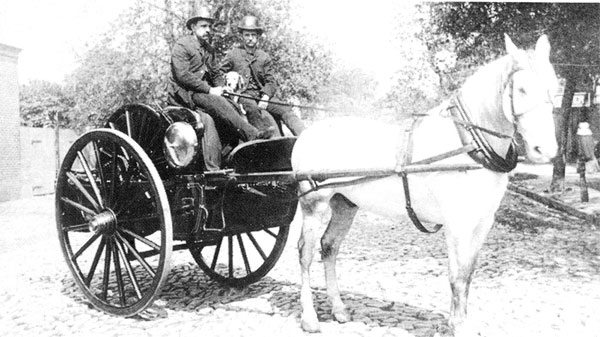
|
|
Engine
Company 2 with 1869 Silsby Hose Cart. Photo
Circa 1890. Note badges
upon derby hats worn by Fire Fighters.
|
Two
Amoskeag second class, double pump, straight frame steam engines were
purchased at a cost of $4250 each. Two Silsby two wheel hose carts,
each of which carried 1000 feet of hose, were another $550 each and
the hook & ladder, built by Schanz and Brother of Philadelphia was
$900. Each engine company received a steam engine and hose cart.
Amoskeag serial #318 went to
Engine Company 1, and
serial #319 to
Engine Company 2. The
Fire Commission also secured the services of the
Weccacoe and Independence steamers in case of fire prior to delivery
of the new apparatus. Alfred McCully of Camden made the harnesses for
the horses. Camden's Twoes & Jones made the overcoats for the new
firemen and a Mr. Morley, also of Camden, supplied the caps and belts
which were manufactured by the Migeod Company of Philadelphia. The new
members were also issued badges.
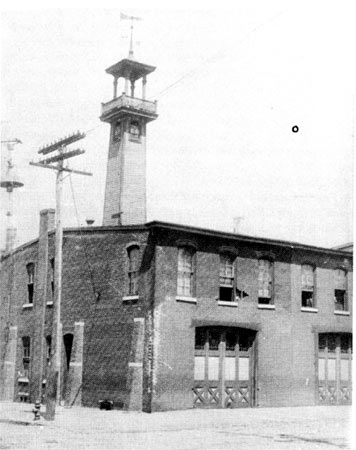
|
This
is the earliest known photo of fire headquarters on the
northwest
corner of
Fifth
and
Arch
Streets. Originally built in 1869, the
building shows signs of wear some twenty years later.
Note the
weathervane shaped like a fireman's speaking trumpet
atop the tower.
Also, the fire alarm bell is pictured to the left of the
telegraph
pole above the rooftop. The bell was removed from the
building once
the fire alarm telegraph system was expanded and in good
working
order.
|
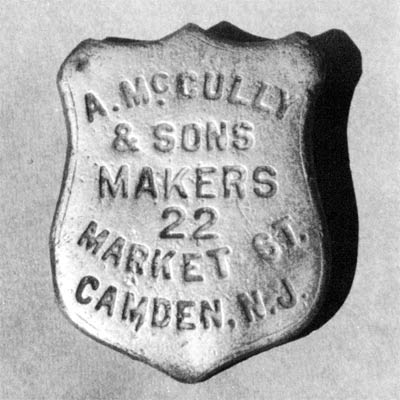
|
This
maker's plate once was attached to a harness made by
A. McCully &
Sons, 22 Market Street, Camden, New Jersey. This
firm provided the
first harnesses for the paid fire department in
1869.
|
Badges
worn by the marshals, engineers, stokers and engine drivers bore the
initial letter of their respective positions and their district
number. The tillerman and his driver used the number "3" to
accompany their initial letter. The extra men of the 1st District
were assigned badges 1-10; 2nd District badges were numbered 11-20 and
the extra men of the hook & ladder wore numbers 21-30.
Although
the Fire Commission intended to begin operation of the paid department
on November 20, 1869, the companies did not actually enter service
until December 7th at 6 P.M. because the new apparatus and buildings
were not ready. The new apparatus was not tried (tested) until
December
9th.
The new members of the paid force were:
|
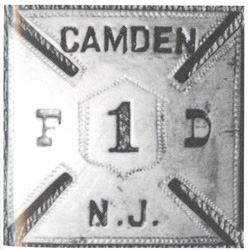
|
The
first style of breast badge worn by members of the
career department
in the City of Camden. 1869. (Courtesy of the
C.C.H.S. Collection).
|
|
